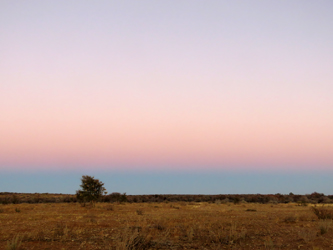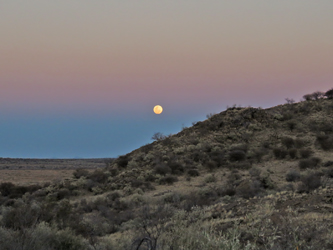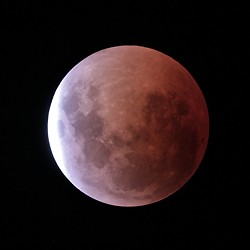|
| |
 |
Special Projects - "all nine", a
planetary parade
In the
Namibian winter of 2018 (July, August) it was possible to observe all 8 planets
(+ Pluto and the bright planetoid Vesta) during the night. Additionally we had
the long lunar eclipse on July 27th and of course the big Mars opposition. The
planetary images on this website were not taken within one night, but within a
few weeks. On July 27th we also opened a Planet Walk at the Rooisand lodge.
(all images can be enlarged by clicking the thumbnails)
Back to Special Projects |
|
 |
|
|
|
|
The picture
above shows the rise of full Moon and planet Mars next to the 4m dome on the
evening of 27 July. The dome still glows in the twilight colours of the sunset.
Click to load a large image.
|
|
|
|
Mercury stood between the middle and at the end of July in the
evening twilight still high in the sky in the constellation Leo. Following
three wide-angle views, taken on 26, 27 and 30 July 2018. All three images can be enlarged by clicking the
thumbnails.
|
 |
 |
 |
Mercury on 26.07.2018
|
Mercury and Venus on 27.07.2018 |
Mercury and Venus 30.07.2018 |
|
|
|
|
 |
 |
VENUS
« The picture on the left shows the
planets Mercury and Venus on July 26, 2018.
« « The picture on the left shows
the planet Venus in the background star field, taken on August 10, 2018 (200mm
telephoto lens).
Both pictures can be enlarged by
clicking on them. |
|
|
|
|
|
On the
right two pictures of the Venus crescent, taken on September 12th (right) and
September 26th.
Celestron SkyRis video module 445C, Celestron C14 +
Baader Q-Turett Barlow element, focal length about 6.500mm
The picture series below shows the planet Venus in UV light. Left
taken on July 30th and right on August 6th. The camera was a ZWO ASI 290,
Celstron C14 focal. A Baader U-Filter was used.
The UV images are the
colored monochrome images. |
 |
 |
|
|
 |
|
|
|
EARTH How can the planet Earth be
visualized in such a planetary parade? Perhaps best with the Earth's shadow
arc. The term is used to describe the shadow cone that the Earth throws out
into space. When imaging with moderate focal lengths, the shadow appears to be
parallel to the horizon, while extreme wide-angle images show that the shadow
is indeed arc-shaped.
Earth shadow rising to the left shortly after
sunset. The middle picture shows the full Moon rise and the Earth shadow, taken
on 27 July, the day of the total lunar eclipse. The right picture shows the
Moon in the shadow cone of the Earth during the total lunar eclipse.
All three pictures can be enlarged by clicking on
them. |
|
|
|
| |
|
|
|
MARS
» » The picture on the right,
taken on 27 July, shows the planet Mars, the eclipsed Moon in the middle of the
eclipse and the southern Milky Way in a wide-angle
image.
» The picture on the right shows Mars in the
background star field, taken on 10 August with a 200mm telephoto lens.
Both images can be enlarged by clicking on
them. |
 |
 |
|
|
That was the
great Mars opposition in July 2018. Day of opposition was the 27th of July. The
distance between Earth and Mars was only 58 million kilometre and Mars shined
with a maximum brightness of -2m8. Unfortunately - as is often the case during
Mars oppositions - an almost global dust storm developed. The image sharpness
and the contrast were partly strongly reduced. The maximum apparent Mars
diameter was 24.2 arc seconds.
The following 11 images were taken with a
Celestron 14 and a 17 inch Planewave astrograph. We used a ZWO ASI 290 and a
SkyRis 445 Color. The focal lengths were partially extended with a Baader
Q-Turett Barlow element. A Baader IR pass filter was used for all monochrome
images.
|
 |
 |
 |
Mars on 4. Juli (C 14)
global dust
storm
|
Mars on 23.Juli (C 14) |
Mars on 25.Juli (C 14) |
|
 |
 |
 |
Mars on 26.Juli (PlaneWave)
|
Mars on 28.Juli (PlaneWave) |
Mars on 30.Juli (C 14) |
|
 |
 |
 |
Mars on 1. August (C 14)
|
Mars on 12. August (C 14) |
Mars on 23. August (PlaneWave) |
|
 |
 |
In the
two best images of 26th (17 inch Planewave) and 30th July (Celestron 14) the
image resolution is certainly 0.5 arc seconds or less.
The effects of
the dust storm and the local seeing conditions are also clearly visible in the
individual images.
« « Mars on 24. August (C 14)
« Mars am on.
September (C 14)
to the outer planets
top of page |
|
|
|
|
|
| All Images and all Content are © by Wolfgang
Paech, Franz Hofmann + Dirk Lucius |


































